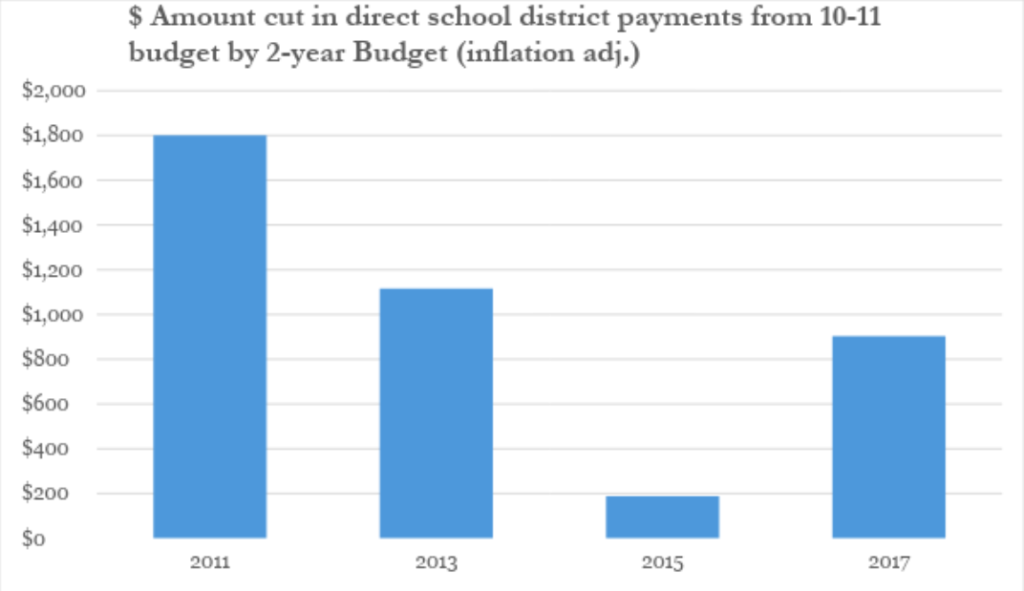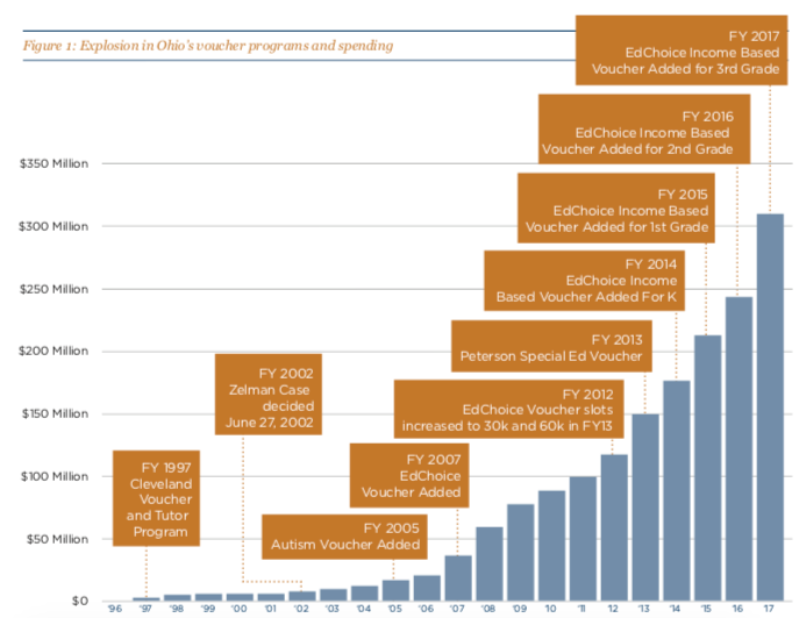What you need to know about Ohio Politics and Policy
Stephen Dyer · March 21, 2019
What’s in DeWine’s K-12 Budget?
Like much of Gov. Mike DeWine’s budget, his K-12 proposals are underwhelming. No New Base Funding Schools see no new change to the school funding formula in the DeWine proposal, as he has left the heavy lifting to State Reps. Cupp and Patterson, who next week will release the most highly-anticipated school funding reform plan in a decade. As we prepare for next week’s proposal, it’s important to have some historical context. When adjusted for inflation, Gov. Kasich’s last budget left schools about $900 million short of what they received in the recession budget 10 years ago. If the state were to base school funding on the actual cost of providing a high-quality education to students, Ohio would currently be about $1.7 billion short, according to figures from the last serious attempt to reform its school funding formula. Thus, any serious new funding formula will require significant new revenue. $300 million a year more for wraparound services
This money would bring more mental health and other services to poor students, providing every district with at least $25,000, even if the district has only a handful of poor students, up to about $250 a student, which could make a real difference.
There would be cause for concern if this becomes a substitute for adequately funding schools. Our students deserve the investment the state simply hasn’t made for 30 years. And every kid deserves that commitment.
Even with $300 million more in the 2020-2021 school year, adjusted for inflation, districts would remain several hundred million dollars short of what they received a decade ago during the Great Recession.
$30 million for high performing charter schools
While Ohio absolutely should begin to differentiate between low and high-performing charter schools, creating a market based on quality rather than enrollment, DeWine is doing so by tapping into the state’s lottery fund, forcing cuts in lottery money headed to traditional public districts. At the end of this two-year budget, nearly $50 million will be headed to charters from the Lottery, which was supposed to go strictly to school districts. We need to be creating a charter school market that rewards success. But taking it out of funds voters created for school districts seems counterproductive.
There is already $16.6 million in the current state budget for high-performing charters to receive capital funding. Not even 25 percent of that amount has been spent because so few charters meet the criteria. Adding $30 million which is limited to the few high performing schools operated in Ohio in hope that more will materialize prevents that money from going to kids in our traditional public school districts.
Another big increase for the voucher program
DeWine continues the misguided increases to the EdChoice, income-based voucher in this budget. EdChoice has actually been shown to harm student achievement. Pouring $24 million more into this program that has hurt the kids who take the vouchers makes little sense. We also need to review amounts going into the other voucher programs when the final budget documents are released to see how much total revenue meant for school districts will be going instead to private, mostly religious schools.
$300 million a year more for wraparound services
This money would bring more mental health and other services to poor students, providing every district with at least $25,000, even if the district has only a handful of poor students, up to about $250 a student, which could make a real difference.
There would be cause for concern if this becomes a substitute for adequately funding schools. Our students deserve the investment the state simply hasn’t made for 30 years. And every kid deserves that commitment.
Even with $300 million more in the 2020-2021 school year, adjusted for inflation, districts would remain several hundred million dollars short of what they received a decade ago during the Great Recession.
$30 million for high performing charter schools
While Ohio absolutely should begin to differentiate between low and high-performing charter schools, creating a market based on quality rather than enrollment, DeWine is doing so by tapping into the state’s lottery fund, forcing cuts in lottery money headed to traditional public districts. At the end of this two-year budget, nearly $50 million will be headed to charters from the Lottery, which was supposed to go strictly to school districts. We need to be creating a charter school market that rewards success. But taking it out of funds voters created for school districts seems counterproductive.
There is already $16.6 million in the current state budget for high-performing charters to receive capital funding. Not even 25 percent of that amount has been spent because so few charters meet the criteria. Adding $30 million which is limited to the few high performing schools operated in Ohio in hope that more will materialize prevents that money from going to kids in our traditional public school districts.
Another big increase for the voucher program
DeWine continues the misguided increases to the EdChoice, income-based voucher in this budget. EdChoice has actually been shown to harm student achievement. Pouring $24 million more into this program that has hurt the kids who take the vouchers makes little sense. We also need to review amounts going into the other voucher programs when the final budget documents are released to see how much total revenue meant for school districts will be going instead to private, mostly religious schools. Preschool flat funded
This was actually shocking. Ohio’s struggles with early childhood education have been stunning, especially given how even conservative states like Oklahoma have created Universal Pre-K. And while there has been a lot of talk about beefing up our state’s early childhood program, this budget is not that.
Significantly more charter school oversight
DeWine increased the budget for ODE’s charter oversight office from $2.5 million to $7 million. That’s good, but still not enough to oversee an $889 million a year industry with a track record of fraud and underperformance.
Workforce Development
Much of DeWine’s workforce development agenda is funded within the K-12 budget, with new resources to help students achieve more industry-recognized credentials. Between 2014 and 2018, the percentage of Ohio students leaving high school with an industry-recognized credential grew from about 4 to just over 6 percent. While that’s a significant increase, it’s still far short of what our students should be achieving. We need more details to understand whether the new money in this budget would be paired with programs to motivate more students to seek these credentials during high school.
Conclusion
Overall, this falls short of the “investment budget” that DeWine promised. There are some small benefits and a few districts will see significant increases to address the real challenges of their most needy students.
But it’s neither enough money to overcome the needs of poor students in every district nor is it enough to overcome the last decade of Kasich budget cuts. All while charters more than double their money from lottery funds, vouchers continue to increase, and early childhood education is all but ignored.
Preschool flat funded
This was actually shocking. Ohio’s struggles with early childhood education have been stunning, especially given how even conservative states like Oklahoma have created Universal Pre-K. And while there has been a lot of talk about beefing up our state’s early childhood program, this budget is not that.
Significantly more charter school oversight
DeWine increased the budget for ODE’s charter oversight office from $2.5 million to $7 million. That’s good, but still not enough to oversee an $889 million a year industry with a track record of fraud and underperformance.
Workforce Development
Much of DeWine’s workforce development agenda is funded within the K-12 budget, with new resources to help students achieve more industry-recognized credentials. Between 2014 and 2018, the percentage of Ohio students leaving high school with an industry-recognized credential grew from about 4 to just over 6 percent. While that’s a significant increase, it’s still far short of what our students should be achieving. We need more details to understand whether the new money in this budget would be paired with programs to motivate more students to seek these credentials during high school.
Conclusion
Overall, this falls short of the “investment budget” that DeWine promised. There are some small benefits and a few districts will see significant increases to address the real challenges of their most needy students.
But it’s neither enough money to overcome the needs of poor students in every district nor is it enough to overcome the last decade of Kasich budget cuts. All while charters more than double their money from lottery funds, vouchers continue to increase, and early childhood education is all but ignored.
Tagged in these Policy Areas: K-12 Education | Ohio State Budget


